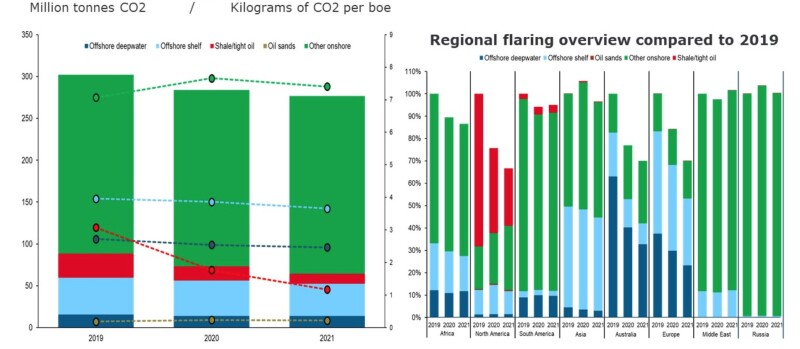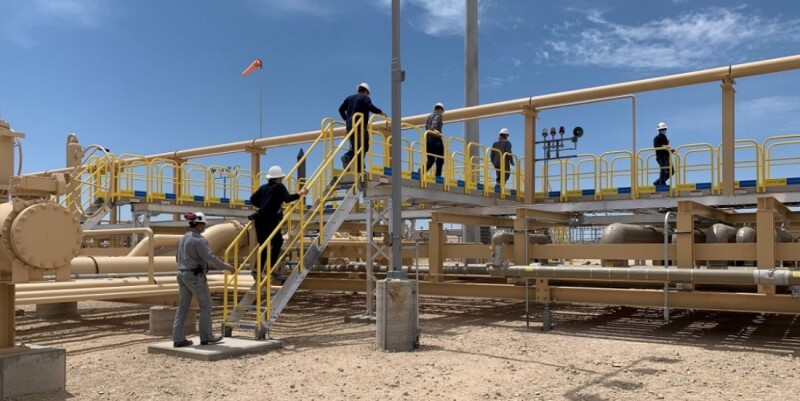While the global effort to reduce flaring has had success in several oil-producing regions, the biggest contributors to global upstream flaring hasn’t changed—Russia, Iraq, Iran, Venezuela, Nigeria, the U.S., Algeria, Mexico, Libya and China—which overall produce more than 70% of global upstream flaring emissions, according to Rystad.
Greenhouse gases (GHG) emitted globally during upstream gas flaring hit their lowest level in a decade in 2021, dropping a marginal 2.5% from 2020 figures; and, while that is good news, the relaxation of COVID-19 restrictions and the tightening of oil and gas supplies because of Russian sanctions could cause this trend to make an about-face in 2022.
Global upstream activity emitted about 276 million tons of carbon dioxide (CO2) from gas flaring in 2021, vs. 283 million tons in 2020, a downward trend initiated at the start of the pandemic, according to a Rystad Energy Research study released on 21 April.
The U.S. dominated tight oil (shale) sector contributed significantly to the decline, flaring the equivalent of about 12 million tons of CO2 in 2021, less than half of the 30 million tons seen in 2019.
The African offshore also showed improvement with a significant reduction in upstream flaring in Algeria as well as a general drop in production across the continent and reduced output from mature offshore wells.
Because flaring is responsible for 30% of the total carbon dioxide emissions produced by the oil and gas industry, “the practice has come under increased scrutiny … in recent years,” Rystad Energy analyst Dzenana Tiganj said, and the reductions seen so far, however marginal, are due in part to increased industry awareness.

The shale sector’s downward momentum of flaring activity (Fig. 1) is the most striking reduction in recent years, dropping 60% on a per-barrel-of-oil-equivalent basis from 2019 to 2021. Flaring during conventional (nonshale) onshore production continued to exceed 7 kg of CO2 per BOE in 2021 or, in some cases, simply remained flat, Rystad said in its report.
Regional Breakdown
When comparing regional differences in the upstream sector, Africa, North America, Australia, and Europe show persistent drops in flaring activity, while other regions remain flat.
Africa’s offshore saw a significant downward trend. The continent’s CO2 emissions from offshore flaring decreased by 4 million tons from 2019 to 2021, a drop that was driven mostly by the abandonment of mature assets, production declines for mature assets, and increased production from less-mature fields.
Angolan and Nigerian production declined from 2019 to 2020, resulting in a reduction of more than 2 million tons of CO2 in offshore flaring volume and a flat performance in 2021. Algeria in 2021 experienced a reduction estimated at 3 million tons of CO2 and a drop of almost 18 kg/BOE, to 13 kg/BOE in flaring intensity.
Rystad called the shift “significant” considering that Algeria’s flaring activity had been steadily increasing throughout the past 10 years.
North America has driven the drop in global flaring since 2019. The US has sought to eliminate routine flaring at shale production sites, and operators are attempting to improve production practices and infrastructure. Satellite data show that flaring has decreased substantially with on-site utilization or redirection of gas for other purposes. US shale production contributed approximately 38% to North American upstream flaring in 2021, compared with 68% in 2019.
Considering all supply segments, including shale, the US continued to perform well throughout 2021, with a decrease of more than 4 million tons of CO2 from 2020 and an overall reduction of flaring intensity by an estimated 30%, reaching 1 kg/BOE in 2021, Rystad said in its report.
Europe continues to decrease routine flaring in the offshore, with the UK being a key driver, reducing flaring emissions by almost 40% from 2019 to 2021. Key operators, such as BP, have implemented improved practices at the well start-up phase and optimized flaring set points to comply with environmental targets and increase fuel efficiency.


